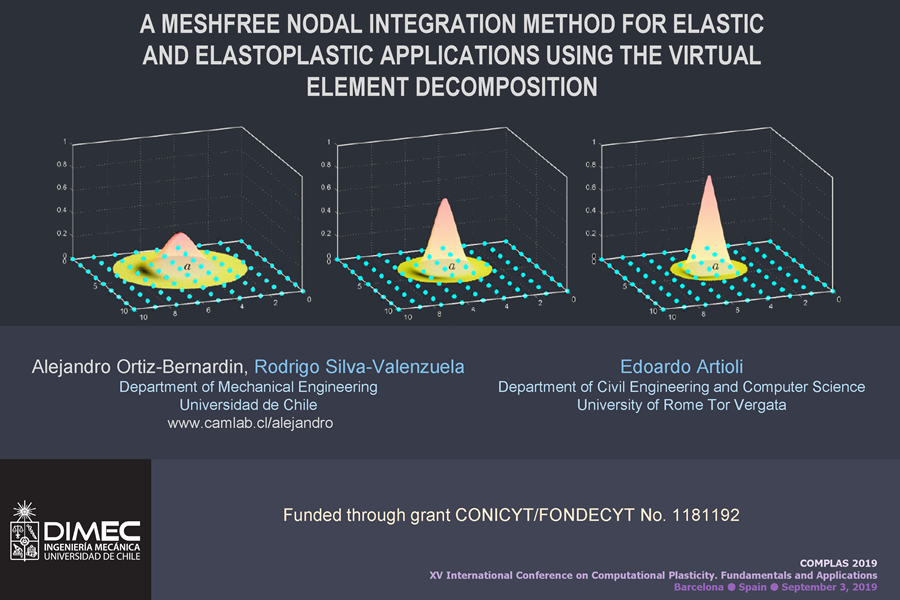A talk given by A. Ortiz-Bernardin at COMPLAS 2019, September 3, 2019, Barcelona, Spain.
A MESHFREE NODAL INTEGRATION METHOD FOR ELASTIC AND ELASTOPLASTIC APPLICATIONS USING THE VIRTUAL ELEMENT DECOMPOSITION
A. ORTIZ-BERNARDIN a, E. ARTIOLI b, AND R. SILVA-VALENZUELA a
Abstract. In meshfree Galerkin methods to solve partial differential equations, a cloud of nodes is used to discretize the domain. On using the nodal data, smooth, compactly-supported, non-polynomial basis functions are constructed to form the trial and test functions. Instead of using Gauss cubature points to compute the weak form integrals, use of nodal integration [1] (material state variables are stored at the nodes thereby avoiding the need for remapping) is attractive for meshfree Lagrangian simulations; however, stability of meshfree nodal integration schemes remains an unsolved problem. This work presents our recent advances on developing nodal integration schemes for meshfree Galerkin methods via the virtual element decomposition [2, 3] on Voronoi cells that are associated with a node. In doing so, both consistency and stability of the meshfree method are ensured. A few benchmark problems in two-dimensional small strain elastostatic and quasistatic elastoplastic applications will be presented to demonstrate the accuracy and robustness of the nodal integration method.
Keywords: meshfree Galerkin methods, nodal integration, Voronoi cells, consistency and stability, virtual element decomposition.
References
[1] M. A. Puso, J. S. Chen, E. Zywicz, W. Elmer. Meshfree and finite element nodal integration methods. International Journal for Numerical Methods in Engineering. 74(3): 416–446, 2008.
[2] L. Beirao da Veiga, F. Brezzi, A. Cangiani, G. Manzini, L.D. Marini, A. Russo. Basic principles of virtual element methods. Mathematical Models and Methods in Applied Sciences, 23(01):199–214, 2013.
[3] A. Ortiz-Bernardin, A. Russo, N. Sukumar. Consistent and stable meshfree Galerkin methods using the virtual element decomposition. International Journal for Numerical Methods in Engineering. 112(7): 655– 684, 2017.
a Department of Mechanical Engineering, Universidad de Chile, Av. Beauchef 851, Santiago 8370456, Chile
b Department of Civil Engineering and Computer Science, University of Rome Tor Vergata, Via del Politecnico 1, 00133 Rome, Italy

